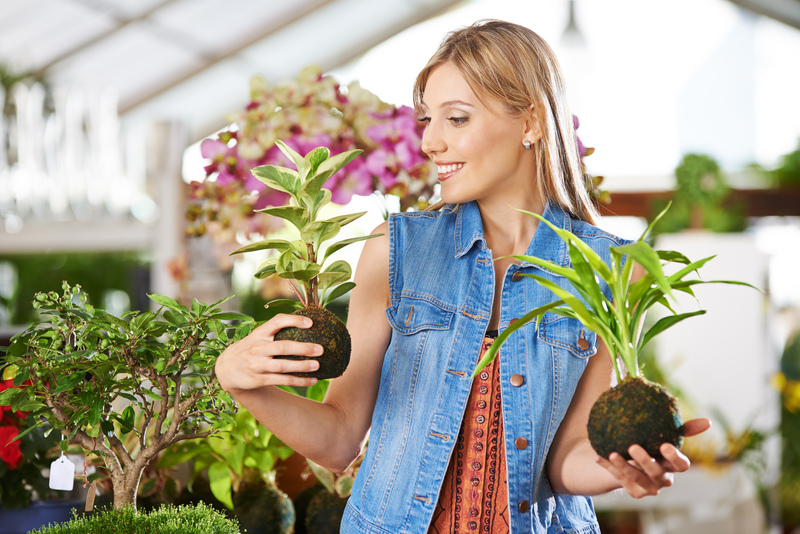Natural partitioning with 9 efficient fast-growing hedges
Posted on 31/05/2025
Natural Partitioning with 9 Efficient Fast-Growing Hedges
Creating natural boundaries in your garden or landscape offers both practical and aesthetic advantages. Traditional fences or walls can sometimes look harsh, but living partitions crafted from fast-growing hedges provide privacy, wind protection, and a lush green backdrop. In this comprehensive guide, we'll explore natural partitioning methods using nine of the most efficient fast-growing hedging plants that transform your space quickly, sustainably, and attractively.

Why Choose Fast-Growing Hedges for Natural Partitioning?
Fast-growing hedges are an exceptional solution for those seeking swift privacy, windbreaks, and a sense of seclusion. These living partitions offer a range of benefits compared to traditional hard landscaping options:
- Environmental Benefits: Hedge plants absorb carbon dioxide, filter pollutants, and support local wildlife by providing shelter and food sources.
- Visual Appeal: Many hedge species display vibrant foliage, seasonal blossoms, or berries, enhancing your garden's visual interest year-round.
- Cost-Effectiveness: While initial planting can require investment, maintenance costs over time are often lower than repairing fences.
- Natural Sound Barrier: Dense greenery helps reduce noise from roads or neighboring properties.
- Versatility: Suitable for marking boundaries, creating secluded areas, or even forming garden 'rooms' for different uses.
Factors to Consider When Choosing Fast-Growing Hedge Plants
- Climate Adaptability: Select species well-suited to your climate and soil type for maximum growth and health.
- Maintenance Level: Some hedges require regular trimming, while others need minimal upkeep.
- Height and Density: Consider your desired privacy level and space availability when choosing a species.
- Evergreen vs. Deciduous: Evergreens maintain foliage year-round, providing continuous screening.
- Wildlife Value: Many species attract beneficial creatures, from pollinators to birds.
Top 9 Efficient Fast-Growing Hedges for Natural Partitioning
Below, you'll find nine of the best fast-growing hedge species for natural partitioning. Each plant offers unique benefits for quick, effective screening and structure in your outdoor space.
1. Leyland Cypress (Cupressus x leylandii)
- Growth Rate: Up to 1 meter per year
- Best For: Tall, dense privacy screens
- Key Features: This evergreen conifer is famed for rapid growth and dense foliage. The Leyland Cypress forms a vibrant green wall, often used for shielding gardens from noise and wind. Regular trimming encourages bushy growth. Suitable for most soils but prefers full sun.
2. Privet (Ligustrum spp.)
- Growth Rate: 30-60 cm per year
- Best For: Formal and informal hedges
- Key Features: With semi-evergreen or evergreen varieties, privet is a classic hedging choice. It's tolerant of different soil types, pollution, and heavy pruning, making it ideal for natural barriers in urban and suburban gardens. White fragrant summer flowers attract pollinators.
3. Green Giant Arborvitae (Thuja standishii x plicata 'Green Giant')
- Growth Rate: 90-120 cm per year
- Best For: Tall, uniform hedges
- Key Features: Popular in North America, 'Green Giant' thrives in a range of soils and is resistant to many pests and diseases. This evergreen forms dense, feathery foliage that maintains color throughout the year. Excellent for large spaces or expansive boundary screening.
4. Cherry Laurel (Prunus laurocerasus)
- Growth Rate: 30-60 cm per year
- Best For: Dense evergreen barriers
- Key Features: Cherry laurel features large, glossy green leaves and copes well with shade and dry conditions. Its robust nature makes it a favorite for town and country gardens alike. In spring, clusters of white flowers appear, followed by small black berries loved by birds.
5. Bamboo (Phyllostachys spp.)
- Growth Rate: Up to 1 meter or more per year
- Best For: Rapid, tall screening
- Key Features: For ultra-fast, exotic natural partitioning, bamboo is hard to beat. Choose clumping varieties to avoid rampant spread. Bamboo gives a unique, modern look while providing dense, upright cover. It rustles in the breeze and creates an attractive sound barrier.
6. Red-Tipped Photinia (Photinia x fraseri 'Red Robin')
- Growth Rate: 30-60 cm per year
- Best For: Colorful, medium-height hedges
- Key Features: Photinia is famed for its vibrant red new growth, contrasting with mature glossy green leaves. It flourishes in sun or semi-shade, tolerates pruning, and adds a splash of seasonal color to natural partitions. It also produces clusters of small white flowers in spring.
7. Escallonia (Escallonia spp.)
- Growth Rate: 30-45 cm per year
- Best For: Coastal screens and flowering hedges
- Key Features: Highly salt-tolerant, Escallonia is perfect for seaside gardens. This evergreen boasts glossy leaves and a profusion of pink, white, or red flowers from summer to autumn. Ideal for mixed borders or to attract bees and butterflies.
8. Griselinia (Griselinia littoralis)
- Growth Rate: 45-60 cm per year
- Best For: Attractive evergreen hedges in mild climates
- Key Features: With large, light green, leathery leaves and a tidy upright habit, Griselinia is becoming increasingly popular. It is particularly effective in maritime climates and responds well to clipping for a neat, contemporary look.
9. Hornbeam (Carpinus betulus)
- Growth Rate: 30-50 cm per year
- Best For: Formal, deciduous hedges
- Key Features: Although not evergreen, hornbeam retains its russet leaves through winter, providing a degree of privacy year-round. Its pleated leaves and tolerance of heavy pruning make it ideal for structured borders and classic fencing alternatives.
Planting and Maintaining Your Fast-Growing Hedge
To ensure your natural partitions flourish, follow these essential steps for planting and care:
- Soil Preparation: Clear the planting area of weeds and enrich soil with compost or well-rotted manure.
- Spacing: Check the mature width of your chosen species and space plants accordingly. Closer spacing leads to faster screening but may require more maintenance long term.
- Initial Watering: Newly planted hedges need regular watering until established, especially in the first two years.
- Mulching: Apply a thick mulch to retain moisture, suppress weeds, and feed the soil.
- Feeding: Use a balanced slow-release fertilizer in spring to support vigorous growth.
- Pruning: Annual pruning encourages dense, bushy growth and neat lines. Some species respond to hard cutting better than others -- always check recommendations for your plant.
- Disease Monitoring: Regularly inspect your hedges for pests and diseases. Many fast-growing hedges are resilient, but vigilance ensures long-term health and appearance.
Creative Uses for Fast-Growing Hedges in Natural Partitioning
Fast-growing hedges are versatile. Here are some creative ways to use them:
- Living Fences: Replace traditional fencing with a lush, living green screen.
- Garden 'Rooms': Use hedges to section large gardens into themed or functional areas.
- Windbreaks: Protect delicate plants or seating areas from strong winds with a dense natural barrier.
- Wildlife Corridors: Connect habitats and encourage biodiversity by planting diverse species.
- Noise Reduction: Plant hedges along busy roads or property boundaries for a quieter outdoor environment.
Addressing Common Concerns with Fast-Growing Hedging Plants
Are Fast-Growing Hedges Invasive?
Some species, particularly running bamboo or Leyland cypress, may become invasive or outgrow their space if not managed. Always choose varieties suitable for your location and garden size and commit to regular maintenance. Clumping bamboos, for instance, are much less invasive than running types.
What About Allergies?
Certain hedge plants, like privet or cypress, may produce pollen that affects allergy sufferers. If this is a concern, opt for species that are less likely to trigger reactions, such as cherry laurel or photinia.
How Fast Will My Hedge Grow?
Growth rates depend on species, climate, soil quality, and care. With proper conditions, most efficient fast-growing hedge plants can provide a substantial screen within 3-5 years--sometimes even sooner!
Sustainable Tips for Natural Garden Partitioning
For an eco-friendly hedging solution, consider the following:
- Mixed Planting: Combine two or more hedge species for biodiversity, enhanced visual interest, and extended flowering periods.
- Native Species: Choose native hedging plants when possible to support local wildlife and maintain ecological balance.
- Waterwise Gardening: Select drought-tolerant hedges if rainfall is limited in your area.
- Pesticide-Free Care: Encourage beneficial insects with flowering hedge species and avoid chemical sprays.

Frequently Asked Questions About Fast-Growing Natural Partitions
How close should I plant hedge shrubs for a dense screen?
Spacing varies by species. For most hedging plants, place them 45-60cm (18-24 inches) apart for a rapid, thick cover. Always check the specific advice for your species.
Can I plant hedges in containers or raised beds?
Many hedge species can adapt to containers or raised beds if given enough room to grow. Smaller-growing varieties like boxwood or Escallonia are good choices. Ensure excellent drainage and regular feeding.
What's the best time of year to plant fast-growing hedges?
Early spring or autumn is generally ideal, allowing roots to establish before the hot summer or freezing winter. Container-grown hedge plants can be installed year-round with careful watering.
Conclusion: Natural Partitioning with Fast-Growing Hedges for Every Garden
Whether you want to enhance privacy, create a windbreak, or add natural beauty to your landscape, fast-growing hedges offer a green, sustainable solution. By choosing efficient species tailored to your local conditions, you'll enjoy vibrant living partitions that mature in just a few seasons. Remember to plan, plant, and maintain your hedges thoughtfully -- and you'll be rewarded with dense, flourishing boundaries that benefit both your garden and the wider environment.
Are you ready to start natural partitioning with fast-growing hedges? Choose your favorite from our top nine and transform your outdoor space with a lush, living screen!



